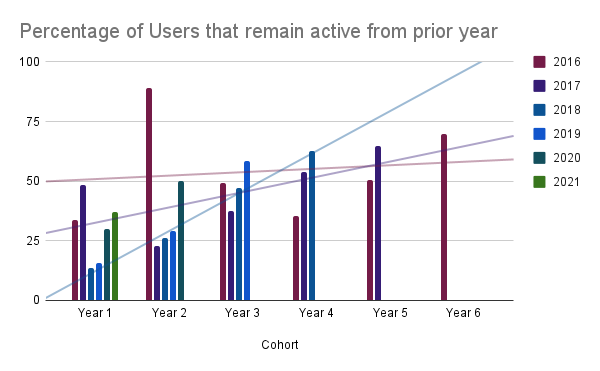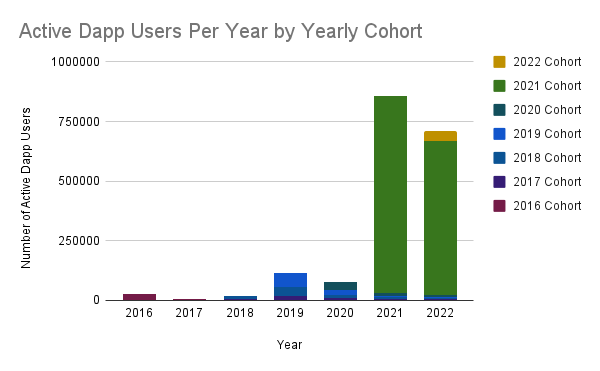Hardcore Users?
In a comment on my post about Hive user retention, @curatorcat asked:
Whereas I probably posted the most in my first year, trying to build the account, I think my annual output has been pretty consistent since then. I wonder if there's a "tipping point" at which people become "long timers," regardless of what the token price does?
There are certainly longtimers I know whom I can hardly imagine leaving Hive now, yet every year every cohort does seem to get smaller. We can test the hypothesis with the data already collected. If it is true, what we would expect is that while a cohort might get smaller every year, the percentage decline each year for a cohort should reduce as the ones who remain are more "hardcore" and less inclined to leave at all.
Here is a chart of the percentage of users which remained from every cohort compared to the previous year. I have included a trend line for the first 3 cohorts. This chart may be influenced by the 2020 Hive exodus hard fork, which will be a different year for each cohort.

Indeed, after a massive drop off in the first two years, the trend is for users who have remained for many years to be more likely to stick around for the next. However it may take until year 4 before they are more likely to remain than to leave. This chart also hints that Hive may have gotten better at user retention in the last couple of years for the newest users, at least compared to 2018-2019 era Steem.
Dapp Users
@blog-beginner also asked
I think projects like Splinterlands, Leofinance are bringing in new users to hive. We need more such projects. There might be many who just interact with the hive blockchain via Splinterlands alone. Are they treated as active ?
As I noted in the post, since I was focusing on social media users (authors and voters), the picture could well be very different if the charts were based on custom_json transactions instead. This would represent likely users of all dapps, as well as the social media users as long as they are marking notifications as read, for example. Here is the chart of user cohorts based on custom_json transactions that have been signed with posting key authority.

As you can see, it is particularly dominated by the 2021 cohort, ie. a large wave of Splinterlands players. This is a more comprehensive set of Hive users, which has grown more in the last two years, but it is likely also much more influenced by bot accounts. Based on past analyses, counting authors is likely the least influenced by bot numbers, but represents a smaller subset of Hive users.
All of the data in this post was collected using @hivesql
Splinterlands has some amazing retention of their players tbh, I know many Gods Unchained players who still play @splinterlands daily but not so much GU anymore. So great job to them, only thing I'd wish is that the players were more aware of what accounts they had and what else they could do with them. If I had a hive for every GU player I onboarded who created a second account because he didn't know he already had a hive account through splinterlands... :p
I've said many times that the various dapps ought to make people aware of other aspects of Hive. Splinterlands players could earn from posting as well as just socialising with other players, but you have to hunt around the site for any mention of Hive. If even 10% of them blogged it would make a difference.
These numbers do show a different picture. There is definitely a good chance that there are a lot of bot accounts too. Unfortunately we have to co-exist.
Proud to be from those of 2017 who are still active 😅
Dapp user growing so fast
It's more that there was a huge number in 2021, but that flood has already stopped. The vast majority of currently active dapp users had their accounts created that year.
I guess people are now seeing more reasons to stay on hive blockchain than to leave compared to before